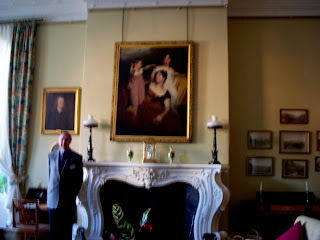
"
This is my office," the young guide said to us in his thick Welsh accent, gesturing from the back of his horse to the packed sand, the ocean, and the sun sinking its golden light over the hills and cliffs of Pembrokeshire. The wind was cold and persistent around us, but the four of us were riding strong, dependable horses on the beach in the evening, and there was little that could detract from the beauty of the moment.
Our shadows stretched across the sand, and I wondered why, when asked what I thought of Wales, I could only say, "It's beautiful." I hoped that, given time, I could put words to this experience, these two weeks that truly feel like a wrapping-up. Each field of sheep and lambs that I pass, each sudden view of the hazy blue ocean, each trek to each ruined castle makes me think about the finality of it all. What I'm leaving, what I'm going toward, the final impression of all that I've seen on my year abroad. These deserve words. Luckily I have one more week to puzzle this out, and there may be no neat answer. I think that would be okay.
Sights & Destinations
We have been seeing Wales from the windows of a coach, from the tops of cliffs and crumbling castle towers, and through the eyes of coal miners, painters, poets. A camera cannot adequately capture the broad expanses and deep crags of the part cliff-jagged, part sand-smooth coastline, or the calm green emptiness of the rolling hedgerowed fields.
Wales shows itself best in the morning or evening sunlight, when the countryside goes yellow or gold and lengthens into shadow. As we depart in the morning, the air is cool and shot through with pale beams of sunlight. In the evening we look for dinner amongst old stone buildings made warm from the sun. (The weather has been good to us; no rain so far.)
Firstly we stopped at Tintern Abbey, and were even able to hike to a location quite some ways above Tintern Abbey. If you forget about the parking lot and tourist shop nearby, you can easily transport yourself to the end of the 18th century. I pictured myself on a boat going down the Wye, an experience I think I would quite enjoy.
Another place we went that I enjoyed was Hay-on-Wye, which is known as being the "Town of Books." This means that it is full of bookshops. It is a town taken over by bookshops, and is the location of a writers festival, about which Margaret Atwood has written. Of course it was a beautiful afternoon when we arrived, and I enjoyed a cookie and an iced coffee while we visited the bookshops. They were so prolific, some were inevitably skipped by us. I particularly wanted to visit the poetry bookshop, though most of the books there were expensive. I did manage to purchase a copy of Great Expectations, as well as Isaac Asimov's Foundation.
Later on we arrived at the best hotel in all the galaxy, fondly called the Dru (short for Druidstone), which is a sort of friendly haven for artists and eclectic characters, being a cafe/bar/restaurant as well as a hotel. It has a wonderful view overlooking an expansive beach, a beach on which a few of us got to ride horses. That was a marvelous experience, and cantering through the surf is a pleasure I won't soon forget. Talking to our guides about their experiences in Australia, and their disdain over their friend who went to Colorado and learned the Western style of riding, which is much more laid-back, and being able to find out more about Pembrokeshire slang, and the satisfaction of working with horses and people; all of this, plus walking the beach, climbing around on the cliffs by myself, eating fabulous dinners with the rest of the group, and passing the time on the gorgeous Welsh coast, it all added up to a delightful two days.
I will miss that place, but today we were leaving Aberystwyth and arrived, quite suddenly, into the midst of mountains. I am from a place that is cradled on both east and west by mountains, and they mean quite a bit to me. So, to find myself among them where for seven months before there had been only rolling hills was striking, and I thought of home. The mountains through which we drove were brown-green and covered in some places by pine trees, dotted with sheep, lambs, and small clusters of stone buildings. It was peaceful to look out the window.
We will shortly be heading to the Lake District; expect more.

 The home of the Aclands. As in the Aclands and Acland Street. Anyway, we went in March during one of our seminars. It's actually quite close to Exeter. A National Trust property, Killerton is well preserved and has an interesting exhibit on fashion on the second floor.
The home of the Aclands. As in the Aclands and Acland Street. Anyway, we went in March during one of our seminars. It's actually quite close to Exeter. A National Trust property, Killerton is well preserved and has an interesting exhibit on fashion on the second floor. Here Kristy and I are competing on Ken-Ex's Next Top Austen.
Here Kristy and I are competing on Ken-Ex's Next Top Austen.




 "Claire! That was in no way the EXCELLENT post you promised! Shame on you!" You're right Ashley. Guess I'll just have to post again!
"Claire! That was in no way the EXCELLENT post you promised! Shame on you!" You're right Ashley. Guess I'll just have to post again!

















